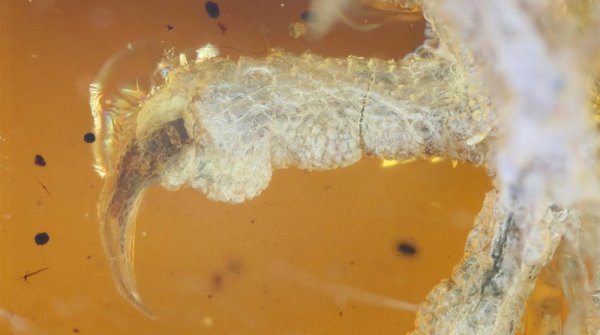99-Million-Year-Old Baby Bird Found Very Well Preserved In Amber
Tags: opinion

Remember the fossil of a mosquito found preserved in Jurassic Park? Something similar but not as old was discovered back in 2017 by scientists in Myanmar. It was a baby bird found encased in Burmese Amber, and it dates back to 99 million years!
That is not the specimen’s only interesting point, however. Scientists claim that it is also the most intact Burmese Amber fossil of a bird ever discovered.
The Baby Bird Had A Short Life
The baby bird belonged to a group of birds called Enantiornithes. The findings were published in a journal called Gondwana Research.
The feathers on the fossil indicated clearly that the baby bird had only lived till the first molting. This means, it had only lived for a few days or at the most, some weeks before it got entrapped inside the amber.
Read: Fossil Found To Be Tiny Bird From 127 Million Years Ago
It is also important to note that the wing feathers of the chick suggest that it could fly almost as soon as it was born. This is very much unlike the birds we see today. In the present day, most baby birds have to be nursed and cared for quite a bit of time by their parents before they learn how to fly.
This bird is believed to have existed since the time of dinosaurs. They were also believed to have gone extinct when the dinosaurs did – somewhere about 65 to 66 million years ago. The Enantiornithes, until this discovery, were believed to have existed till the Cretaceous period.

The latest discovery has shed light on significant information about these birds and how they differ from modern species. The fossil was reconstructed using computers so as not to tamper with the specimen. The final resting position of the baby bird suggests that it had known that death was coming as the resin slowly encased it.
Researchers stimulated the molting process of the bird to figure out the possible coloration of the feathers. It has a range of colors from dark gray to brown and white. As such, the baby bird was nicknamed “Belone”. Belone is the local Burmese name for larks found in the area.
The Discovery Of The Amber
The specimen only measures around 9 centimeters. Amber collectors originally found it in Myanmar’s Yukon Valley. In 2014, Tengchun City’s Chinese Amber Museum’s director had acquired it, where it remained until it was rediscovered.
The fossil is only partially visible from the outside. To the layman, it looked like a strange lizard’s paw. But experts suspected that there was more to it than meets the eye.

Read: Study Explains Why Crocodiles Today Look The Same As They Did 200 Million years Ago
Additional CT scans were conducted of the fossil. The findings were spectacular: the level of preservation was unprecedented. The amber also contained air bubbles, clay particles, and plant remains that obscured the fossil.
Enantiornithes remains have been located in every continent except Antarctica. During the Cretaceous period, they lived in the forests of Gondwana and Laurasia, continents that existed at that time. The bird has characteristics that are no longer found in any modern species. These include having teeth in place of beaks, and claws on their wings.

The baby bird specimen revealed that the wings were entirely feathered. However, the rest of the body did not have as much of a plumage. Moreover, the fact that they could fly from birth came with a consequence: their growth rates were slow. As such, the birds were more vulnerable when it came to the long term.
Check out Truth Theory Youtube Channel and subscribe to stay updated, click here
Image credits: Royal Saskatchewan Museum/R.C. McKellar

Leave Comment: